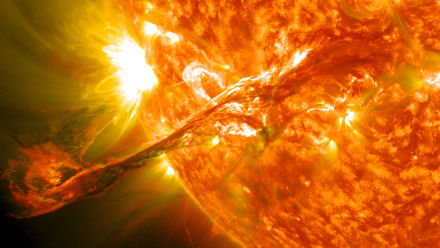22 May 2013
Physics-defying magnetic field behavior in solar flares explained
by Will Parker

When a solar flare filled with charged particles erupts from the Sun, the flux-freezing theorem dictates that the magnetic lines of force should flow away in lock-step with the particles - whole and unbroken. But scientists have observed that the magnetic lines of force sometimes break apart and then quickly reconnect in a way that has defied explanation. Now, however, this flouting of a widely accepted rule of physics may finally be explained.
In a paper published in Nature, an interdisciplinary research team led by a Johns Hopkins mathematical physicist says it has found a key to the mystery. "The flux-freezing theorem often explains things beautifully," said Gregory Eyink, lead author of the study. "But in other instances, it fails miserably. We wanted to figure out why this failure occurs."
Developed 70 years ago, the flux-freezing theorem states that magnetic lines of force are carried along in a moving fluid like strands of thread cast into a river, and thus they can never "break" and reconnect. But within violent solar flares, the principle does not always hold true.
Studies of these flares have determined that their magnetic field lines sometimes do break like stretched rubber bands and reconnect in as little as 15 minutes, releasing vast amounts of energy that power the flare. "But the flux-freezing principle of modern plasma physics implies that this process in the solar corona should take a million years!" Eyink said. "A big problem in astrophysics is that no one could explain why flux-freezing works in some cases but not others."
Some scientists suspected that turbulence was playing havoc with the behavior predicted by this principle. To find out, Eyink teamed up with other experts in astrophysics, engineering, and computer science.
The team developed a computer simulation to replicate what happens under various conditions to the charged particles that exist in a plasma state of matter within solar flares. "Our answer was very surprising," Eyink said. "Magnetic flux-freezing no longer holds true when the plasma becomes turbulent. Most physicists expected that flux-freezing would play an even larger role as the plasma became more highly conducting and more turbulent, but, as a matter of fact, it breaks down completely.
In an even greater surprise, the researchers found that the motion of the magnetic field lines becomes completely random - not just chaotic, but; "as unpredictable as quantum mechanics. Rather than flowing in an orderly, deterministic fashion, the magnetic field lines instead spread out like a roiling plume of smoke," Eyink describes.
The research could lead to a better understanding of solar flares and mass ejections of material from the sun's corona. Such powerful "space weather" can endanger astronauts, knock out communications satellites and even lead to massive blackouts of electrical power grids on Earth.
Related:
Discuss this article in our forum
Solar flares spookily linked to radioactive decay on Earth
Sun's Iron Core May Be Cause Of Solar Flares
Solar power's dirty secret: skyrocketing lead pollution
Source: Johns Hopkins University
